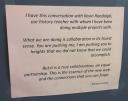 I enjoy the times when our AP US History Teacher, Kevin Randolph, and I sit down to talk about embedding new ways of learning and new tools to accomplish the learning goals he wants to achieve within his classroom. On Wednesday, asked him to help me brainstorm about what to present at our end of the year Upper School faculty meeting. I have been give the last time slot of the last meeting of the year, with a special luncheon right after my presentation. I have to make the presentation short, sweet, and to the point while planting seeds that hopefully germinate as my colleagues begin to unwind over the summer.
I enjoy the times when our AP US History Teacher, Kevin Randolph, and I sit down to talk about embedding new ways of learning and new tools to accomplish the learning goals he wants to achieve within his classroom. On Wednesday, asked him to help me brainstorm about what to present at our end of the year Upper School faculty meeting. I have been give the last time slot of the last meeting of the year, with a special luncheon right after my presentation. I have to make the presentation short, sweet, and to the point while planting seeds that hopefully germinate as my colleagues begin to unwind over the summer.
I know that I want to show some highlights of the 13 Days that Changed America project, because I feel that the process that we are all going through on this project, Kevin, the student, and I, is an excellent model of what we should be aiming for. This is a collaborative project, with individual elements, that allow the students to first begin to answer an excellent question, research the event, analyze the significance of the event, and presenting their findings to a global audience, so that they can get feedback from others. There are creative uses of new technologies (wikis, VoiceThread, and Digital Story Telling software) for them to craft their message. This is truly a collaboration, with teachers serving as guides and mentors to the students on this project, as equals, not as dispensers of knowledge.
Kevin suggested that in the faculty meeting, that a podcast consisting of the reflections of the students to this project would be a valuable and be a more authentic voice to share with the faculty. Agreeing with Kevin, I began to think about how we would go about and complete this. While thinking, I had an “aha” moment, why not use the tools and technology to enable this.
Enter Gabcast, a service that allows for someone to call into a phone (land line or cell phone) into a toll-free number, and with a channel number and PIN, record their message. I first found out about this service while “attending” a session at the K12 Online Conference last October and I have been seeking the right project to incorporate this. I shared this option with Kevin, who was very excited about allowing students to use their phones and cell phones as an experiment to record their reflections.
In five minutes, we came up with the following questions we are asking the students to share their thoughts about this project. They are:
- Did the elements of the project(research, analysis, collaborative learning) reflect the nature of the course?
- How is the creation of a digital movie an effective way to present an argument as opposed to writing a paper?
- What is the benefit of working collaboratively as opposed to working independently on a project such as this?
- Was this an effective wrap up project for this AP US History course?
- What are the benefit of using new technologies (PhotoStory, VoiceThread, Gabcast) on a project such as this?
- How you change the project?
I am anxious to hear their thoughts and will mash up them up in a podcast that I will share via this space. Now, I have to finish up my segment, which I will try to share my reflections on the process over the weekend.